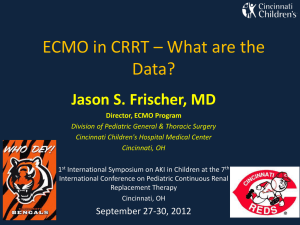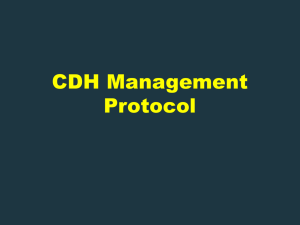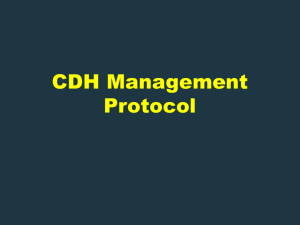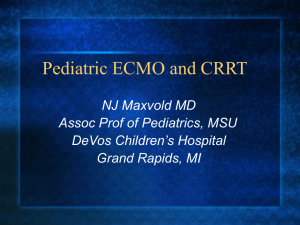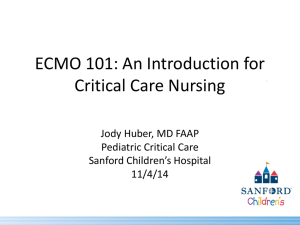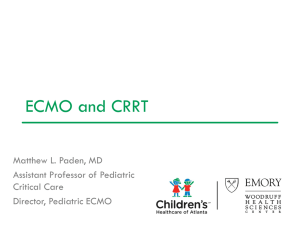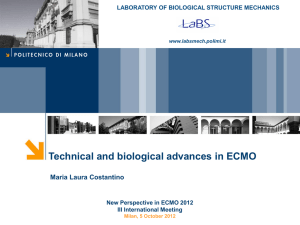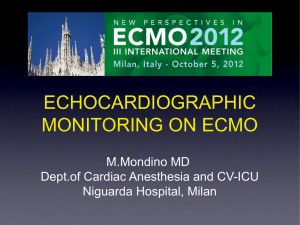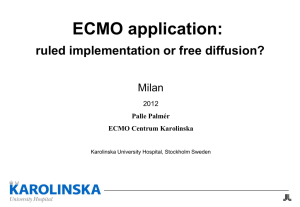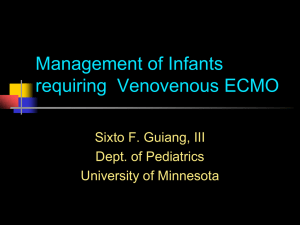PCRRT in ECMO - Pediatric Continuous Renal Replacement Therapy
advertisement
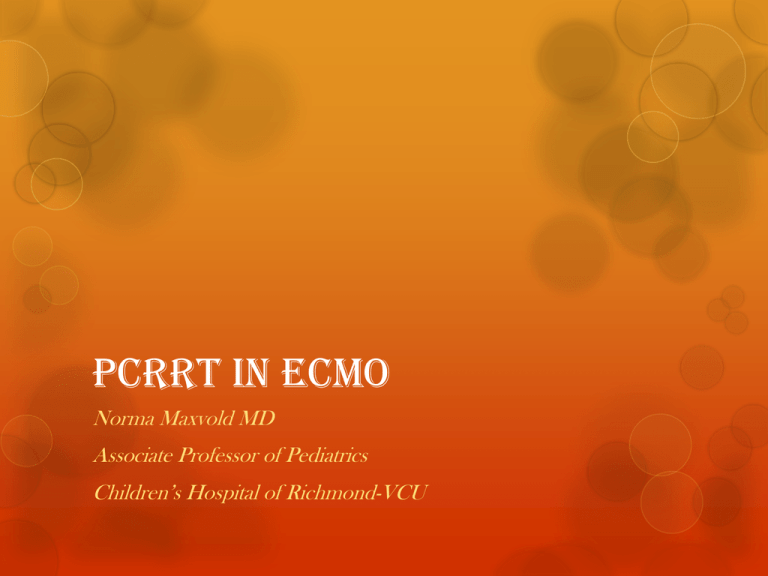
PCRRT in ECMO Norma Maxvold MD Associate Professor of Pediatrics Children’s Hospital of Richmond-VCU PCRRT in ECMO Objectives: 1. Review of CRRT Role in ECMO population 2. Understand the CRRT Filter Set-up with the ECMO System 3. Review Effectiveness of CRRT in the ECMO population PCRRT in ECMO Extracorporeal Membrane Oxygenation (ECMO) Began in 1970’s , First in Neonatal g Pediatric g Adult ELSO Registry now has ~ 90 US Centers, participate in Broad database Warehouse of ECMO support. Length of support range of hours to weeks (longest ECMO run 117 days) Indications not responding to other conventional therapies Cardiopulmonary Support Reversible underlying Process PCRRT in ECMO Indications/Role of CRRT in ECMO: Decrease fluid overload Management of fluid balance to improve nutritional support Removal of Inflammatory Mediators Control of Electrolyte/Solute abnormalities Decreased use of furosemide Pathophysiology of AKI in ECMO: Similar to General Critical Care I.Vascular / Ischemic Injury: a. Sepsis b. Low Cardiac Output c. Hypovolemia II. Nephrotoxins: a. Medications: NSAIDS,Antimicrobials,Chemotx b. Endogenous: Rhabdomyolysis, Tumor Lysis,Hemolysis c. Contrast dyes III. Miscellaneous: a. CardioPulmonary Bypass b. Acute Compartment Syndrome c. Other PCRRT in ECMO Incidence of AKI in ECMO population: Single centers ≈ 70-85% Breakout groups: Neonates with CDH 71% Criteria: Gadepalli SK et al J Pediatr Surg 2011;46:630-635 RIFLE Pediatric Cardiac 71% Smith AH et al ASAIO J 2009;55(4):412-416 FO, Electrolyte Disorder, GFR<35ml/min/1.73m2 Adults Post Cardiotomy 78% Lin CY et al Nephrol Dial Transplant 2006;21:2867-2873 Adults Post Cardiotomy RIFLE 81-85% Yan X et al Eur J Cardiothorac Surg 2010;37:334-338 RIFLE , AKIN PCRRT in ECMO Use of RRT in ECMO population: Single centers Data Breakout groups: Neonates with CDH AKI% CRRT% 71% 16% Gadepalli SK et al J Pediatr Surg 2011;46:630-635 Pediatric Cardiac 71% 59% Smith AH et al ASAIO J 2009;55(4):412-416 Adults Post Cardiotomy 78% 35% 81-85% 45% 38% 30% Lin CY et al Nephrol Dial Transplant 2006;21:2867-2873 Adults Post Cardiotomy Yan X et al Eur J Cardiothorac Surg 2010;37:334-338 Ped Respiratory Hoover NG et al Intensive Care Med 2008;34:2247 ELSO Registry Data: 1998-2008 Population: AKI: RRT: Both: Neither: Neonatal (7941) 3% 18% 5% 74% Pediatric 26% 16% 54% Adult (1962) (1011) 4% 7% (Non-cardiac) Askenazi et al Pediatric CCM 2011 15% 27% 51% PCRRT in ECMO Fleming GM, et al. ASAIO J 2012. 58(4):407-14 Survey of ELSO Centers Fluid overload (43%) Prevention of fluid overload (16%) AKI (35%) Electrolyte abnormalities (4%) PCRRT in ECMO Fluid used in Early Goal directed Therapy to restore perfusion is GOOD!! Key Component to the Sepsis Bundle Initiative Prolonged Accumulation of Fluid during Critical Illness NOT GOOD! FO studies : Independent Mortality Risk Factor Is it the Fluid Overload itself or the Severity of Capillary Leak Process resulting in the FO???? PCRRT in ECMO Goldstein SL, et al: Pediatrics 107:1309-1312, 2001 Texas Children’s Hospital 21 pediatric ARF patients Survival benefit remains even after adjusted for PRISM scores FO % Foland JA, Fortenberry et al. Crit Care Med, 2004 Children’s Healthcare of Atlanta at Egleston 113 pediatric patients on CVVH Multivariate analysis • Percent fluid overload independently associated with survival in ≥ 3 organ MODS F O % Gillespie RS, et al. Pediatr Nephrol 19:1394-1399, 2004 Seattle Children’s Hospital 77 pediatric patients • If pre-CRRT percent fluid overload >10% 3.02 times greater risk of mortality (95% CI 1.56.1, p=0.002) PCRRT in ECMO Fluid Overload in ECMO Population: UMich ECMO Database (7/06-9/10) 53 Pediatric Patient on ECMO+CRRT Survival 18/53(34%) Survivors Nonsurvivors FO Initiation CRRT 24.5% 38% FO Discontinued CRRT 7.1% 17.5% Selewski DT, et al Crit Care Med 2012 PCRRT in ECMO Hoover et al Intensive Care Med 2008; 34:2241-2247 PCRRT in ECMO Renal Recovery after ECMO and CRRT: Meyer RJ et al, Pediatr Crit Care Med 2001 U Mich ECMO Database (1990-1999) 35 neonatal /children on ECMO + CVVH 15 survivors (43%) Renal Recovery in 14/15 (93%) Paden et al, CCM 2007 Egleston ECMO Database (11/97-12/05) 95 neonatal /children on ECMO + CVVH 55 survivors (57%) Renal recovery in 53/55 (96%) Cavagnaro et al, Int J Artif Organs 2007 Santiago Chile ECMO database (5/03-5/05) 6 Infants on ECMO+CRRT 5 Survivors (83%) Renal Recovery in 5/5 (100%) Pediatric CRRT and ECMO Mortality : AKI RRT Neonate Survival: AKI 27.4% 19% 39.7% 72.6 % 3.9% 41.6% 32.3% 58.9% 58.4% 12% RRT 16% (7941) Pediatric (1962) Mortality Odds Ratio AKI RRT Neonates 3.2 1.9 Pediatric 1.7 2.5 Askenazi et al Pediatric CCM 2011 30.8% PCRRT in ECMO Two modes of Interface for CRRT: 1.Use of inline hemofilter with IV/syringe pumps 2. Tandem stand-alone CRRT devices in parallel Potential error rate noted with excess fluid removal over “expected” both for inline device and commercial device PCRRT in ECMO POSITIVE VENOUS PRESSURE PCRRT in ECMO CRRT Error Rate Increases with Increasing Flow/Pressure Sucosky, Paden et al., JMD, in press 2008 PCRRT in ECMO Extracorporeal Blood Volume= Oxygenator+Pump System+ CRRT PCRRT in ECMO PCRRT in ECMO PMP Oxygenators Smaller prime volume Shorter blood path Less pressure drop across the membrane Centrifugal pumps New levitating impeller based designs Continuous flow - afterload dependent Eliminates risk of raceway rupture Risk of negative pressure generation PCRRT in ECMO Managing Pressure No CRRT device is FDA approved/designed for use with ECMO Pressure alarms are common Too negative/positive drain pressures Too negative/positive return pressures No uniform solution currently exists Changing/removing alarm parameters Adding flow restriction via tubing/clamps Altering circuit entry points PCRRT in ECMO Summary: CRRT can be provided in line with ECMO With ability to meet nutritional goals more readily with improved fluid balance with decreased furosemide exposure Potential risks of excess fluid removal but close monitoring with scheduled weighed UF volume can identify this early for adjustment during therapy. Success of ECMO and CRRT dependent on the primary disease and it’s expression within the patient

